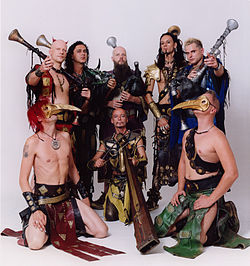Corvus Corax (band)
| Corvus Corax | |
|---|---|
 |
|
| Background information | |
| Also known as | die Könige der Spielleute (the Kings of Minstrels) |
| Origin | Germany |
| Genres | Neo-Medieval music |
| Years active | 1989–present |
| Labels | Pica Records, Noir Records |
| Associated acts | Tanzwut |
| Website | corvuscorax.de |
| Members | Castus Rabensang Wim Panpeter Vit Norri (Harmann der Drescher) Hatz Steve |
| Past members | Mike "Teufel" Paulenz Martin Ukrasvan Meister Selbfried Brandan Donar von Avignon Jagbird Mr.Poettner Jean Strahli Ardor Patrick Jordon |
| Notable instruments | |
| bagpipes | |
Corvus Corax is a German band known for playing Neo-Medieval music using an abundance of authentic instruments. Their name is the Latin name for the common raven. The band was formed in 1989 by Castus Rabensang, Wim (Venustus) and Meister Selbfried ("Master Selfpeace") in East Germany. The band often uses bagpipes as the solo instrument; their live performances attract attention with the bizarre look of the musicians being reminiscent of ancient Greek myths: half-naked, dressed in unusual clothes, wearing primitive tribal decorations, often tattooed.
Today the band consists of seven members: Castus Rabensang ("Castus Ravensong"), Panpeter, Norri (formerly known as Harmann der Drescher), Hatz ("hunt"), Steve, Vit and Wim (Venustus). In May 2005 Meister Selbfried, one of the Corvus Corax founders and the researcher of medieval music, decided to cease his active musicianship and to dedicate himself mostly to managing Corvus Corax's own label Pica Records. His place in the line-up was taken by Jordon Finus in 2006.
The band releases its music through Pica Records in Europe and Noir Records in the USA. The Cantus Buranus projects have thus far been released in Europe by Roadrunner Europe.
Because medieval music theory was dominated by ecclesiastics, it is often difficult to determine from the existing manuscripts just how the secular medieval music sounded. Corvus Corax draws on a number of sources to try to make their music as authentic as possible: they have used documents that "condemn profane music" as an indicator of what the music might have sounded like, and drawn on nineteenth century scholarly treatises for information. In many cases these treatises are unreliable, as they impart more nineteenth century interpretations of medieval music than factual information on what the music was like.
But the profane music of the day was often accompanied by a droning bass tone similar to that generated by the bourdon stop on an organ, which is provided in Corvus Corax's case by the drones on their bagpipes. An inkling as to the harmonies used is found in a song by Walter von der Vogelweide, in which he calls for the song to be played "the old way", meaning harmonising with thirds. At the time, the third was considered an awkward, ugly interval by the sacred musician — like the tritone, or diabolus in musica — but it was a common interval in folk music.
...
Wikipedia
